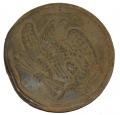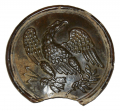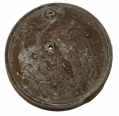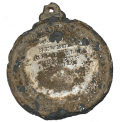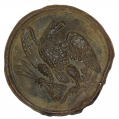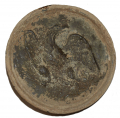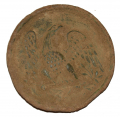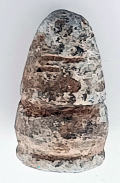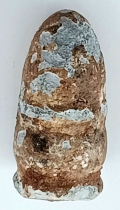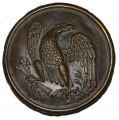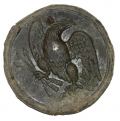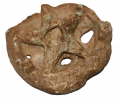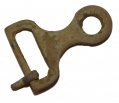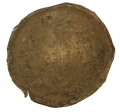site search
online catalog
Relics
Showing 251 to 300 out of 353
NICE .69 CALIBER “HIGH BASE” FRENCH TRIANGLE BASE BULLET
This scarce bullet is in dropped condition with a light gray/tan patina. This is the tall variant of the .69 caliber French bullets. Flat nose, single wide groove, and triangular cavity. In very fine,… (2022-2527). Learn More »
CRUDE .54 CALIBER CONFEDERATE BULLETS – NOSE CAST
These three-groove minie balls would have been for the .54 caliber Mississippi rifle or .55 caliber Austrian Lorenz. This style bullet features a smooth body, three fine grooves, is nose cast, and has… (2022-2672). Learn More »
.52 SHARPS BULLET FROM COLUMBIA, SC (PALMETTO SHARPS)
This is one of the Sharps bullets recovered from the Congaree River which runs past the site of the State Arsenal in Columbia, SC. The condition is very good. The patina is dark gray as were all from… (2022-2538). Learn More »
TRIPLE DEADEYE FROM FARRAGUT’S FLAGSHIP USS HARTFORD
This 8-inch iron-bound wood deadeye, used in pairs to tighten ship shroud lines, is in very good condition and comes with a 1975 notarized letter from the collector who obtained if 1957 when the USS… (1196-13). Learn More »
RELIC VIRGINIA MANUFACTORY BAYONET
Bayonet is complete with a full-length triangular blade and mortised socket. Both are encrusted with a thin layer of rust. The blade face is wide with no visible fuller. Socket meas. approx. 3 3/16 of… (490-3270). Learn More »
RELIC MODEL 1851 CADET BAYONET
Bayonet is complete with a full-length triangular blade, socket and frozen locking ring. All are encrusted with a thin layer of rust. No markings are visible. The Cadet musket was authorized in 1851,… (490-3223). Learn More »
MAINE VOLUNTEER MILITIA CARTRIDGE BOX PLATE FROM CASTLEMAN’S FERRY
This is a nice chocolate brown color excavated VMM box plate found at Castleman’s Ferry, Virginia. This is on the Shenandoah River and was the scene of the Battle of Cool Spring in 1864, but was the… (766-1541). Learn More »
$1,250.00
Originally $1,450.00
RARE .36 CALIBER “DOUBLE-END” BULLET FOR THE VANDENBERG VOLLEY GUN
The Vandenberg volley gun was the invention of a former New York militia officer, General Origen Vandenburg. Based on the French Mitrailleuse weapons design of the 1850s, the Vandenburgh consisted of… (2022-2613). Learn More »
MAINE “VMM” CARTRIDGE BOX PLATE
These plates for wear on the flaps of the cartridge box followed the standard U.S. 1839 version, but with VMM, instead of U.S., stamped in the rolled brass for “Volunteer Militia of Maine.” These… (1156-33). Learn More »
DROPPED US .58 CAL. SWAG BASE MINIE BALL RECOVERED AT GETTYSBURG BY JOHN CULLISON
This item was recovered by local Gettysburg resident John Cullison, who excavated relics on the field from 1935-1959. Cullison sold his collection to the famed Rosensteel family of Gettysburg, who… (R17319). Learn More »
FIRED US .69 CAL. ROUND BALL RECOVERED AT GETTYSBURG BY JOHN CULLISON
This item was recovered by local Gettysburg resident John Cullison, who excavated relics on the field from 1935-1959. Cullison sold his collection to the famed Rosensteel family of Gettysburg, who… (R17318). Learn More »
RARE SQUARE-SHANK WILLIAMS BULLET FOR UNION REPEATING GUN (AGAR, COFFEE MILL)
.58 caliber, Union Repeating Gun bullet, early pattern with two deep “V” shaped grooves and square pin. Smooth tan patina. Two large dings on one side, still weaving a good displayable side.… (2022-2551). Learn More »
POSSIBLE RICHMOND MANUFACTURED BAYONET FOR THE LORENZ
Bayonet is complete with a full-length triangular blade, socket and frozen locking ring. All are encrusted with a thin layer of rust. No markings are visible. The socket is thin and crudely made. The… (490-3226). Learn More »
.69 CALIBER PRESSED AND TURNED “NO-RING PRUSSIAN” BULLET
Offered here is a very nice example of a Northern, arsenal-made bullet. This style of bullet was machine pressed to form the nose and cavity, then turned on a lathe to finish the shoulder and grooves.… (2022-2627). Learn More »
.58 CALIBER MINIE BALL WITH CASTING FLAW
Here is a “dug” three-groove minie ball with a slight extension from the cavity. This flaw is likely caused by the base plug not being properly seated in the mold. This casting error has made for… (2022-2518). Learn More »
RARE .58 CALIBER “RALEIGH” BULLET
Here is an example of the rarest size of the Confederate Raleigh pattern bullet. With typical raised bands and pointy nose, but in .58 caliber. Manufactured at the North Carolina Institute for the… (2022-2624). Learn More »
CONFEDERATE CAST .577 CALIBER ENFIELD BULLET WITH TEAT
For the Enfield P-1853 rifle, but also used in the .58 caliber Springfield rifle musket. This specimen is a .577 caliber Enfield, cast in the South, teat base. Nice patina. [jet]… (2022-2561). Learn More »
.577 CALIBER ENFIELD BULLET WITH [6-SPOKE/RIMLESS WHEEL]
For the Enfield P-1853 rifle, but also used in the .58 caliber Springfield rifle musket. Enfield bullets made in England were machine pressed. A punch that formed the cavity was often engraved and… (2022-2557). Learn More »
DROPPED US .69 CAL. MINIE BALL RECOVERED AT GETTYSBURG BY JOHN CULLISON
This item was recovered by local Gettysburg resident John Cullison, who excavated relics on the field from 1935-1959. Cullison sold his collection to the famed Rosensteel family of Gettysburg, who… (R17317). Learn More »
PULLED US .58 CAL. MINIE BALL RECOVERED AT GETTYSBURG BY JOHN CULLISON
This item was recovered by local Gettysburg resident John Cullison, who excavated relics on the field from 1935-1959. Cullison sold his collection to the famed Rosensteel family of Gettysburg, who… (R17311). Learn More »
PATTERN 1826 EAGLE BREAST PLATE RECOVERED AT FREDERICKSBURG
Plate is in solid condition. There are no visible cracks or chips. The edge is complete with no missing brass however one side is pushed in a bit causing the plate to be out of round. Eagle is… (2022-1425). Learn More »
DUG PATTERN 1826 EAGLE BREAST PLATE
Face has a wonderful dark patina throughout. Detail to the eagle is very good however the plate has a small piece of missing material at bottom center. Reverse has 100% of the lead fill with a nice… (595-1901). Learn More »
DUG PATTERN 1826 EAGLE BREAST PLATE WITH BAYONET MARKS
Face has a dark patina throughout with small light patches of discoloration. Detail to the eagle is good. Reverse has 100% of the lead fill with a nice smooth finish. Only one of the hooks are… (595-1903). Learn More »
EXCAVATED CIVIL WAR ID DISK – BATTLE HONORS BUT NO NAME
Pewter “WAR OF 1861” style identification disk. In “dug” condition showing expected small chipping and edge wear. Much of the plating remains on the front and back faces. The side that would… (2022-2442). Learn More »
SKIN ONLY OF A US PATTERN 1826 EAGLE BREAST PLATE
Skin is in good condition with no cracks or missing material. Nice patina to the face and good detail to the eagle. One edge is slightly pushed causing the plate to be out of round a bit. Reverse has… (1184-97). Learn More »
DUG PATTERN 1826 EAGLE BREAST PLATE
Face is in nice condition and free of cracks and chips. Detail to the eagle is good however some of it is subdued due to the contrasting light and dark surface patina. Reverse has 100% of the lead and… (565-1902). Learn More »
PATTERN 1826 EAGLE BREAST PLATE RECOVERED AT FREDERICKSBURG
Plate is in solid condition. There are no visible cracks or chips. The edge is complete with no missing brass. Eagle is slightly subdued by the brown dirt patina which has filled in some of the lower… (2022-1428). Learn More »
RELIC PATTERN 1853 ENFIELD BAYONET
Bayonet is complete with a full-length triangular blade, socket and frozen locking ring. All are encrusted with a thin layer of rust. No markings are visible. Location of recovery is not known. … (490-3225). Learn More »
$145.00
ON HOLD
RELIC MODEL 1816 SOCKET BAYONET - POSSIBLE CS
Bayonet is complete with a full-length triangular blade and socket with mortise. All is encrusted with a thin layer of rust. No markings are visible. Half-way down the length of one of the blades… (490-3272). Learn More »
RARE “DUG” RELOADABLE IRON CHAMBER FOR AGAR/UNION REPEATING GUN
Offered here is an iron tube that was used in the .58 caliber, Union Repeating Gun (aka Coffee Mill gun, Agar). Paper cartridges were loaded into these reusable iron chambers. The chamber features… (2022-2815). Learn More »
RARE 90-BORE (~.36 CALIBER) BULLET FOR CHRISTIAN SHARPS PISTOL
This is the scarce bullet for the Christian Sharps pistols manufactured between 1857-1858. Solid bullet, raised bands, tie ring, nipped sprue on base. This pattern of bullet, with extended ring,… (2022-2612B). Learn More »
RARE 90-BORE (~.36 CALIBER) BULLET FOR CHRISTIAN SHARPS PISTOL
This is the scarce bullet for the Christian Sharps pistols manufactured between 1857-1858. Solid bullet, raised bands, tie ring, nipped sprue on base. This pattern of bullet, with extended ring,… (2022-2612A). Learn More »
CONFEDERATE .36 CALIBER COLT REVOLVER BULLET – 3RD PATTERN, RICHMOND LABORATORY
.36 caliber bullet for Colt and other “Navy” revolvers. This is the later-war, enlarged, 3rd pattern bullet made at the Richmond Laboratory. This bullet has a more-bulbous nose, solid base and one… (2022-2506). Learn More »
FIRED .52 CAL. SPENCER BULLET RECOVERED AT GETTYSBURG BY JOHN CULLISON
This item was recovered by local Gettysburg resident John Cullison, who excavated relics on the field from 1935-1959. Cullison sold his collection to the famed Rosensteel family of Gettysburg, who… (R17340). Learn More »
MAINE “VMM” CARTRIDGE BOX PLATE FROM ORANGE, VIRGINIA
These plates, measuring 56 X 87mm, followed the standard U.S. 1839 version, but with VMM stamped in the rolled brass indicating Volunteer Militia of Maine. These were paired on equipment with the… (1184-148). Learn More »
CIVIL WAR NCO ROUND EAGLE SHOULDER BELT PLATE
These plates were introduced in 1826 for use on the bayonet shoulder belt. When the bayonet was switched to wear on the waistbelt in the early 1840s these plates with hooks were relegated to use on… (1184-136). Learn More »
EARLY RELIC FIRE STRIKERS (A.K.A. STRIKE-A-LIGHTS)
Offered here are a variety of steel fire strikers; the “steel” part of “flint and steel.” A fire striker is a piece of carbon steel from which sparks are struck by the sharp edge… (160-93). Learn More »
FIRED .577 ENFIELD BULLETS RECOVERED AT GETTYSBURG BY JOHN CULLISON
This item was recovered by local Gettysburg resident John Cullison, who excavated relics on the field from 1935-1959. Cullison sold his collection to the famed Rosensteel family of Gettysburg, who… (R17332). Learn More »
DROPPED .54 CAL. MINIE BALLS RECOVERED AT GETTYSBURG BY JOHN CULLISON
This item was recovered by local Gettysburg resident John Cullison, who excavated relics on the field from 1935-1959. Cullison sold his collection to the famed Rosensteel family of Gettysburg, who… (R17331). Learn More »
US PATTERN 1826 EAGLE BREAST PLATE, FROM G.A.R. POST 551 COLLECTION (YORK SPRINGS, PA)
This Federal shoulder belt plate is of the regulation 1826 pattern. Constructed in the die-struck and rolled brass method, the brass accoutrement’s face shows a clear eagle in the center. Face has a… (2022-1849). Learn More »
RELIC WORLD WAR ONE BRITISH SMLE WIRE CUTTER HEAD
During World War One the ubiquitous wire cutters played an important role in trench raids and assaults. Leading elements would use these cutters to penetrate the enemies wire entanglements and clear a… (490-3926). Learn More »
RELIC – BIG BROKEN BRASS SPUR FROM ORANGE, VIRGINIA
This is about half of an excavated spur…very large and heavy western-style spur. This piece consists of one are and the neck/rowel. The other arm is broken off and missing. Measures approximately… (1184-389). Learn More »
FIELD-MADE COPY OF STAR AND CRESCENT CAPE PIN
This is an excavated relic from a camp near Orange, Virginia. Using a brass star and crescent cape pin, some creative or bored soldier made this piece. Creating a mold by pressing the original cape… (1184-288). Learn More »
DUG BRASS BULLET MOLD
This is a very nice brass bullet mold. In “dug” condition, the brass has an even green patina. Measures 4” long overall. The mold is stuck partially opened. It has two cavities; casting two .31… (1184-337). Learn More »
RELIC ISAAC & CAMPBELL KNAPSACK HOOK
This is an excavated Confederate knapsack buckle from an imported knapsack manufactured by S. Isaac Campbell & Company in London. This company supplied numerous articles of war to the… (1184-304). Learn More »
RELIC STATE OF NEW YORK “SNY” BELT PLATE
This is a nice excavated SNY belt plate. Pattern 1839 belt buckle with puppy-paw hooks. Beautiful brown face with the letters “SNY” in the center. Light wear over face with smooth chocolate brown… (2022-1554). Learn More »
SKIN ONLY OF A US PATTERN 1826 EAGLE CARTRIDGE BOX BREAST PLATE DUG AT FREDERICKSBURG
The face is slightly discolored from ground action leaving a mix of dark and light patina. The darker portion is along the bottom half of the eagle. The surface of the plate has a light waviness to it… (2022-1410). Learn More »
RELIC PAIR OF CIVIL WAR ENLISTED SHOULDER SCALES
Introduced in 1851 for mounted troops, brass shoulder scales were decorative, but were also meant to be a shoulder defense against saber cuts. In 1854/55 they became regulation for all branches of… (1184-299). Learn More »
CONFEDERATE .69 CALIBER “BRITISH SEA SERVICE” RIFLED MUSKET BULLET
Collectors call this a “British Sea Service” bullet because of its reference in a very early bullet reference book. However, there is no research to support this. It is a Confederate-made bullet… (1184-365). Learn More »
CONFEDERATE .50 CALIBER “MACON” CARBINE BULLET
Known as the Macon carbine bullet for no particular reason, this bullet features a round nose, two grooves, and a solid base. Bullet has been fired but remains in excellent condition with only faint… (1184-369). Learn More »
Showing 251 to 300 out of 353
Most Popular
Historical Firearms Stolen From The National Civil War Museum In Harrisburg, Pa »
Theft From Gravesite Of Gen. John Reynolds »
Selection Of Unframed Prints By Don Troiani »
Fine Condition Brass Infantry Bugle Insignia »
British Imported, Confederate Used Bayonet »
Scarce New Model 1865 Sharps Still In Percussion Near Factory New »
featured item
SCARCE NEW MODEL 1865 SHARPS STILL IN PERCUSSION NEAR FACTORY NEW
There are no appreciable differences between the NM1863 and NM1865 Sharps other than the stamped model designation by the company, and its occasional absence, which some have speculated was due to worn out or broken old dies, or was a marketing ploy… (490-2531). Learn More »





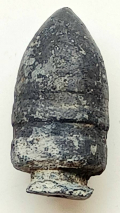




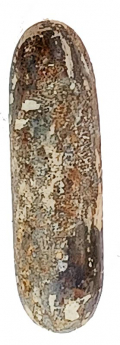



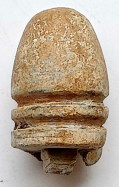

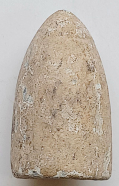
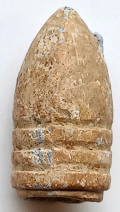
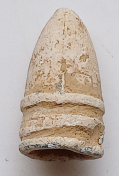

![.577 CALIBER ENFIELD BULLET WITH [6-SPOKE/RIMLESS WHEEL]](/images/product/43/186013_tn.jpg)


